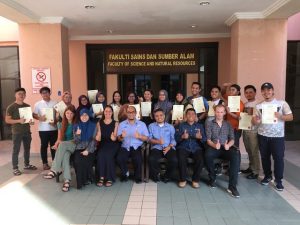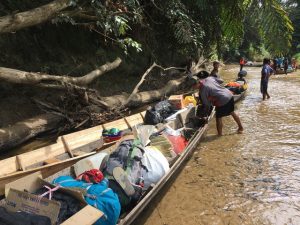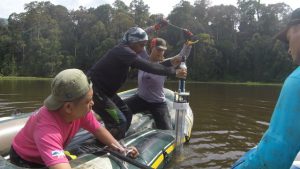
September 24, 2019, by lzzeb
The Origins and History of Lake Linumunsut Fieldwork Blog
A blog by Brittany Pugh, second year Undergraduate student
This summer we undertook a palaeolimnology research expedition to Lake Linumunsut in Maliau Basin, Borneo, Malaysia. Our aims; to produce the first ecological assessment of the lake, to assess the impact of long-range atmospheric pollution in the region and to promote international research collaboration. Our expedition team was comprised of Dr. Virginia Panizzo from the University of Nottingham (UoN), Dr Patrick Frings from GFZ research institute in Germany and research assistants Noor Ain Yahya from the Universiti of Malaysia Sabah (UMS) and Brittany Pugh, also from UoN.
Maliau Basin is a virtually untouched 590 km2 region, critical for regional biodiversity with >400 species of trees and >250 recorded species of birds (many of which are endemic and/or on the IUCN red list of globally threatened species). Lake Linumunsut is a rare geomorphological landform in the area, being the only lake in Maliau Basin. This makes it ideal for producing a paleoecological record in order to better inform Maliau Basin Management Committee (MBMC) on the best course of action for planning future ecotourism to the lake and preventing the expansion of bordering logging and palm oil plantations to the conservation area. The lake is also of great cultural importance to local people in the Tongod region, to whom we hope to provide an accurate account of the history of the lake site.
Funded by the National Geographic Explorer’s Grant, this project is in collaboration with MBMC. The project was kicked off in Kota Kinabalu with a 2-day palaeolimnological workshop at UMS. Increasing understanding of paleolimnology as a discipline as well as to inspire a new generation of geochemists.
After a long drive to Maliau Basin Studies Centre it was time to organise our kit; this was important as much of it has been transported halfway around the world! After meeting our Maliau ranger team, we headed to the village of Inarad II where we were warmly welcomed into the chief’s house, meeting the villagers accompanying us to the lake site. Our expedition team was finally assembled; 20 members, 6 traditional long wooden fishing boats and 3 engines.
After months of planning, it was finally time for us to head into the jungle. Unfortunately, due to an unusual dry period in the region, the river which we were using to trek up for 2 days, to reach the lake site, had an exceedingly low water level. This meant that we could not actually use our boats for more than 30 minutes. Instead of the boats carrying us, it was us carrying the boats! After an exhausting 2-day trek to the lake site over large boulders, through the jungle and under equatorial heat it was time to kick off the real fun; fieldwork!
After wading through thigh-high mud to enter Lake Linumunsut, we took a bathymetric survey of the lake using an echosounder and GPS, revealing that the lake was an impressive 1m in depth! We then took a habitat survey, measured the secchi disk photic zone depth, calculated the perimeter of the lake via GPS and marked it’s inflows and outflow. In addition, contemporary water samples and most importantly, 7 sediment cores were also collected. These then had to be extruded (essentially sliced into samples 0.5cm at a time) over the next 3 days in order to transport back to UMS and the UK for analysis.
After a difficult 2-day trek downstream with all of our samples, the team returned to Maliau Basin Studies Centre where we delivered a slideshow and brief presentation on our research to staff and local high school students as part of their Environmental Education fieldtrip.
It was a great privilege to be a research assistant on this expedition. I feel as if I have learned a great deal more about the world of research and expanded my world view via international collaboration; I look forward to learning what the results for this project indicate about this amazing part of the world.
For more information on our trip and updates on the research, following us on @linumunsut!
Please note, all photo credits are of the National Geographic Explorer Grant Team.
No comments yet, fill out a comment to be the first





Leave a Reply